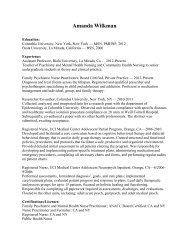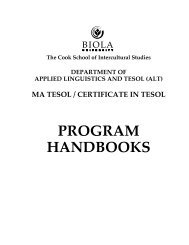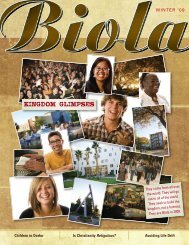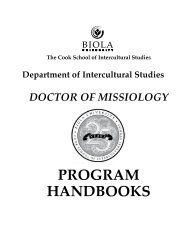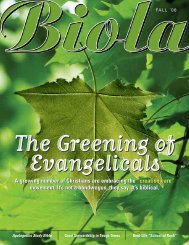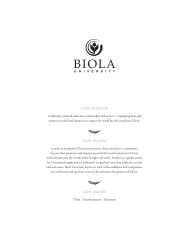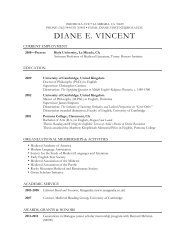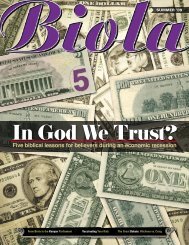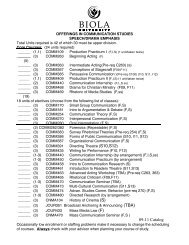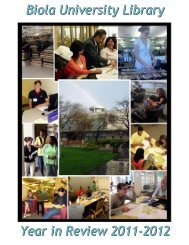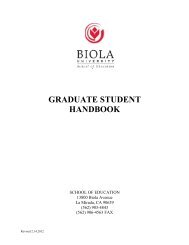Dawkins' God Delusion Divorced American ... - Biola University
Dawkins' God Delusion Divorced American ... - Biola University
Dawkins' God Delusion Divorced American ... - Biola University
You also want an ePaper? Increase the reach of your titles
YUMPU automatically turns print PDFs into web optimized ePapers that Google loves.
Exposing ‘E-Rumors’<br />
Rich Buhler (’68) — a broadcast journalist —<br />
founded TruthOrFiction.com in 1998 to give people<br />
a quick way to check out the accuracy of forwarded<br />
e-mails (which he calls “e-rumors”). Buhler’s<br />
Web site receives up to 11 million hits a month and<br />
has been featured on television news outlets,<br />
including CNN, MSNBC and BBC. Buhler shared<br />
his e-rumor experiences with <strong>Biola</strong> Connections.<br />
With the advent of e-mail, the e-rumor has become<br />
the underground news service of the world. An<br />
e-rumor can be established as fact in the minds<br />
of millions of people in a matter of hours.<br />
E-rumors are what I call “wow stories,” and we all<br />
share them. Often bizarre, funny, inspiring or<br />
scary, they are fascinating reflections of people’s<br />
hopes, fears and beliefs.<br />
The granddaddy of all Christian e-rumors is the one<br />
about Madalyn Murray O’Hair, the famous<br />
<strong>American</strong> atheist, who allegedly filed a petition<br />
with the Federal Communications Commission<br />
to remove religious programming from radio<br />
and television. She never filed such a petition,<br />
but this rumor refuses to die (even though she<br />
has). The FCC has received tens of millions of<br />
complaints about the phony petition.<br />
The subject of rumors, hoaxes and urban legends is<br />
an entertaining one. The lessons learned,<br />
however, are important to life.<br />
E-rumors aren’t just silly stories. They can damage<br />
reputations, spread misinformation about<br />
people or products, and some can be scary — like<br />
those claiming medical information.<br />
Many of us have had the experience of forwarding an<br />
e-mail and then feeling the sting of several<br />
replies telling us the story is hogwash.<br />
One recent e-rumor that turned out not to be<br />
“hogwash” is that a 1,000-pound feral hog was<br />
killed by two men on a plantation in Georgia.<br />
The hog didn’t turn out to be 1,000 pounds, but<br />
it was a huge one at about 800 pounds.<br />
BIOLA CONNECTIONS ❁ SPRING ’07 BIOLANS UP CLOSE 33<br />
Some people create e-rumors to cause harm to a<br />
specific person or group by spreading misinformation.<br />
For example, a national restaurant chain<br />
has been fighting a false e-rumor that claims that a<br />
chef intentionally contaminated a steak with body<br />
fluids after a customer complained about how it<br />
was cooked, causing the customer to get sick. It’s<br />
caused loss of business for the restaurant.<br />
Many e-rumors are created or embellished by a part<br />
of us that wishes they were true.<br />
One e-rumor that was probably created this way is<br />
about a store clerk who contracted a serious virus<br />
by coming into contact with soft-drink cans with<br />
dried rat urine on them. The story isn’t true, and<br />
the virus couldn’t be contracted that way, but<br />
somebody who has an obsession with cleanliness<br />
would find it satisfactory to create this story.<br />
The angriest feedback I’ve received was when I<br />
exposed an e-rumor that circulated shortly after<br />
9/11 known as “The Photo of the Last Tourist From<br />
Thomas Fluharty<br />
On Top of the World Trade Center.” The photo,<br />
taken by an Eastern European prankster, obviously<br />
wasn’t from the same time of day as the 9/11 attacks<br />
because the angle of the sun was wrong and the type<br />
of airliner in the background was wrong. But some<br />
people who had cried for the tourist and prayed for<br />
his family wrote us saying that we shouldn’t<br />
discredit this young man’s memory.<br />
The study of e-rumors helps us be more alert to false<br />
information we might be guilty of believing and<br />
passing along to others in our everyday lives — at<br />
home, with friends or at work.<br />
The study of e-rumors can strengthen our Christian<br />
faith. It’s very important to me that Jesus is not an<br />
urban legend. Whereas rumors lack first-hand<br />
sources, the number of first-hand stories about<br />
Jesus from people who knew him is enormous,<br />
and the kicker is how many of them were willing<br />
to die for it. Critics can speculate whether his<br />
followers were misled, but nobody can accuse<br />
them of participating in a hoax.<br />
Rich Buhler At A Glance<br />
Hometown: Villa Park, Calif.<br />
Family: Wife, Dianne (Folkerts, ’67); 10<br />
children (four of whom graduated from<br />
<strong>Biola</strong>); seven grandchildren<br />
Education: B.A. in psychology, <strong>Biola</strong>;<br />
honorary doctor of laws degree, <strong>Biola</strong>;<br />
honorary doctor of humane letters<br />
degree, Trinity College<br />
Business: Rich is the president of<br />
Branches Communications in California,<br />
a Radio-Television-Film production<br />
company.



